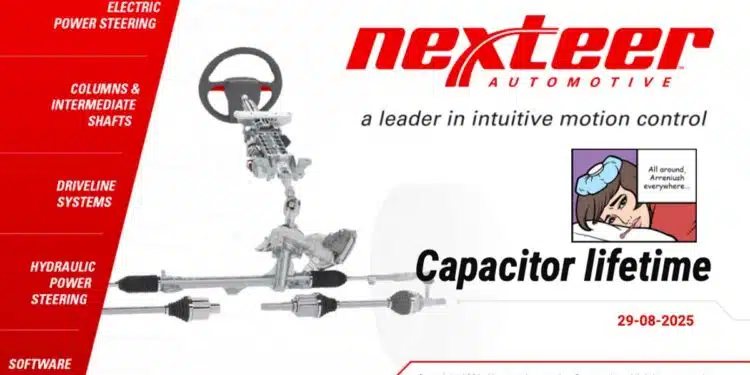The paper “Lifetime assessment for capacitors in EPS Electric Power Steering application” was presented by Krzysztof Ptak, Nexteer Automotive Europe, Tychy, Poland at the 5th PCNS Passive Components Networking Symposium 9-12th September 2025, Seville, Spain as paper No. 2.4.
Introduction
This article explores the complex topic of lifetime assessment for capacitors used in Electric Power Steering (EPS) applications. It delves into the historical origins of lifetime equations, the 10-degree rule, and the connection between reaction speed and aging phenomena.
The author highlights the challenges engineers face in understanding and applying lifetime equations, particularly under variable loads and temperatures. The paper also raises open questions for the industry regarding missing data, unclear reliability levels, and non-standardized specifications.
Key Points
- Lifetime equations for capacitors are derived from chemical reaction rate theories, particularly the Arrhenius and Berthelot approaches.
- The 10-degree (RGT) rule forms a key basis for temperature-dependent aging assumptions.
- Statistical treatment of lifetime data is often missing or unclear in capacitor OEM specifications.
- Historical studies from the 19th and 20th centuries—spanning chemistry, metallurgy, and reliability engineering—inform today’s lifetime assessment practices.
- Open questions remain regarding cumulative damage, reliability levels (Bxx or Lxx), and the correlation between endurance tests and real-life performance.
Extended Summary
Capacitors in EPS systems are critical because their failure can result in severe safety consequences, including loss of steering assist. While engineers use lifetime equations to estimate performance and validate designs for automotive OEMs, the underlying principles are often not widely understood. The paper traces the origins of lifetime equations to historical studies of reaction rates in chemistry, beginning with Arrhenius and van’t Hoff, and the 10-degree rule (RGT) that links temperature rises to reaction speed doubling.
The author examines how lifetime assessment evolved from early reliability studies in mechanics and materials, noting parallels with the Weibull and log-normal statistical distributions used to model fatigue, grain size, and breakdown behavior. Historical figures like Gompertz, Kurtz, and Winfrey contributed to the understanding of survival curves, while later work by Montsinger, Akahira, and Büssing connected thermal aging of insulation to reaction kinetics.
The article further explores the role of power law relationships for voltage stress and the application of cumulative damage models, such as the Palmgren-Miner rule, to estimate life under variable conditions. However, the author emphasizes that capacitor lifetime equations often lack clarity on critical aspects:
- No explicit link between calculated lifetime and confidence or reliability levels.
- Limited sample sizes and zero-failure endurance tests make statistical validation difficult.
- OEMs rarely define how to handle cumulative thermal and electrical stress in real-world conditions.
Statistical considerations are crucial. While exponential, log-normal, and Weibull distributions are all used in reliability engineering, capacitor OEMs typically do not specify which model underpins their life equation. This opacity makes it difficult for end users to compare products or assess risk reliably. Historical comparisons to ball bearings (B10/L10 life) and LED lifetimes show that other industries provide clearer reliability metrics than capacitors.
The paper also highlights that the lifetime equation is effectively an engineering approximation: Berthelot-style adaptations of Arrhenius behavior provide safe, conservative estimates across the relatively narrow temperature ranges experienced in capacitor applications. Weight loss analysis, thermogravimetric data, and other degradation modeling approaches illustrate the deep connection between chemical reaction kinetics and observed aging.
Finally, the article presents open questions for the industry, urging OEMs to standardize how lifetime equations relate to statistical confidence, define cumulative damage rules, and clarify the link between endurance tests and field reliability.
Conclusion
The lifetime assessment of capacitors in EPS applications is grounded in a long history of chemical, material, and statistical research. The current lifetime equations used by OEMs are empirical, often conservative, and built on reaction-speed concepts dating back over a century. However, the lack of standardized statistical definitions, reliability levels, and cumulative damage treatment leaves end users with significant uncertainties. The paper calls for the industry to address these gaps to improve clarity, predictability, and trust in capacitor lifetime specifications.





























